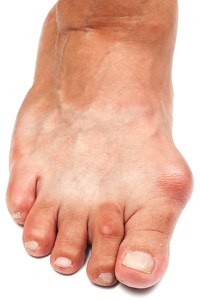 A large bony bump on the side of the big toe is referred to as a bunion. It can occur as a result of genetic factors, and from shoes that are worn which do not fit correctly. There may be inadequate room for the toes to move freely in, and this may cause the big toe to gravitate to the toe next to it. There are common symptoms that are often associated with bunions, including red and hardened skin over the affected toe, and it may be difficult to move and to wear shoes. Mild relief can be found when larger shoes are worn, and it may be helpful to wear a protective pad on top of the toe. For severe bunions, surgery could be a successful treatment option for permanent removal. If you are afflicted with a bunion, it is suggested that you seek the counsel of a podiatrist who can properly manage this condition.
A large bony bump on the side of the big toe is referred to as a bunion. It can occur as a result of genetic factors, and from shoes that are worn which do not fit correctly. There may be inadequate room for the toes to move freely in, and this may cause the big toe to gravitate to the toe next to it. There are common symptoms that are often associated with bunions, including red and hardened skin over the affected toe, and it may be difficult to move and to wear shoes. Mild relief can be found when larger shoes are worn, and it may be helpful to wear a protective pad on top of the toe. For severe bunions, surgery could be a successful treatment option for permanent removal. If you are afflicted with a bunion, it is suggested that you seek the counsel of a podiatrist who can properly manage this condition.
If you are suffering from bunion pain, contact Dr. Harry I. Zirna of Lockport Foot Care, PLLC. Dr. Zirna can provide the care you need to keep you pain-free and on your feet.
What Is a Bunion?
Bunions are painful bony bumps that usually develop on the inside of the foot at the joint of the big toe. As the deformity increases over time, it may become painful to walk and wear shoes. Women are more likely to exacerbate existing bunions since they often wear tight, narrow shoes that shift their toes together. Bunion pain can be relieved by wearing wider shoes with enough room for the toes.
Causes
- Genetics – some people inherit feet that are more prone to bunion development
- Inflammatory Conditions - rheumatoid arthritis and polio may cause bunion development
Symptoms
- Redness and inflammation
- Pain and tenderness
- Callus or corns on the bump
- Restricted motion in the big toe
In order to diagnose your bunion, your podiatrist may ask about your medical history, symptoms, and general health. Your doctor might also order an x-ray to take a closer look at your feet. Nonsurgical treatment options include orthotics, padding, icing, changes in footwear, and medication. If nonsurgical treatments don’t alleviate your bunion pain, surgery may be necessary.
If you have any questions, please feel free to contact our offices located in Lockport, NY . We offer the newest diagnostic and treatment technologies for all your foot care needs.
